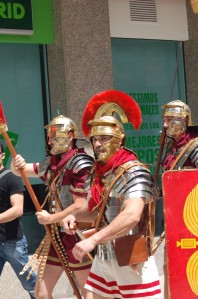 by Carmen Ferreiro Esteban
by Carmen Ferreiro Esteban
Romans roamed the streets of Lugo, my hometown in Spain, the day I arrived last June.
After two decades of living abroad, I had come to visit my family and my high school friends, and, to my American daughter’s dismay, to speak my native tongue too fast for her to understand. What I had not anticipated when planning my trip was to find the city ablaze.
I knew, of course, Lugo had been founded by Roman legionnaires two thousands years ago. As a child, every day in my way to school, I had crossed the old city through the arches on the Roman walls that encircle it. During the summer, I had followed the Roman road that descends to the river, and crossed the waters over the Roman bridge. But, like the city itself restrained within its walls, the Lucenses, the people from Lugo I remembered were proud and shy, and wary of foreigners.
Instead in the city I encountered, a multitude had poured into the streets; some wearing togas, the men, and long shifts, the women, as Romans did, while others donned the earth colors favored by the Celts, the tribes the Roman conquered.
That Friday, the first day of my stay, I watched the legionnaires patrol the streets and the auriga (a light Roman chariot) ride to an admiring crowd. I shopped at the Macellun, the open market, set at the Plaza Mayor, where peddlers sold their wares, of leather and iron, dates and teas, and artisans showed how to make bread, and wine and the process of pressing olives into oil the Roman way. Later, I sipped sweet mint tea squatting under an Arabian tent (an anachronism no doubt) while a hawk perched on its owner’s shoulder watched unblinkingly.
On Saturday the feast resumed. Outside the city, chariots competed at the circus, while in the Roman encampment set by the walls, boys practiced with arrows on straw targets, while white horses grazed indifferent in the afternoon sun.
Late in the evening, couples were married following Celtic or Roman rites, and, at midnight a representation of the wall was burned over the hill overlooking the river and fireworks lit the sky.
Afterwards in front of the City Hall, a wizard attended the burning of the orujo, the fire water of ancient lore that was later distributed in small cups among the crowd.
On Sunday, all around the walls, tables were laid with white tablecloths and clay dishes for the “Comilonum” a three course lunch that took place under the high sun.
And that concluded the celebrations as, that very night, the Roman legions broke their camps and left to conquer new lands.
I left too, two weeks later, reluctant and yet content, the memories of my childhood not replaced by enhanced by new ones, memories of the three days the city had burned in celebration of a Roman past people couldn’t possibly remember but were only too willing to embrace.
Carmen Ferreiro-Esteban
Sandra Carey Cody said,
May 31, 2009 at 3:07 pm
What a wonderful post, Carmen. I was right there with you, celebrating your heritage. Maybe some day I’ll get to see it in person. In the meantime, you’ve made it alive for me.
carmenferreiroesteban said,
June 1, 2009 at 1:15 am
Hi Sandy,
I am so glad you like it.
beth@buybikini.org said,
June 30, 2010 at 4:23 am
I’ve been reading your blog now for quite some time and really love it. I don’t know if it’s your style or not , but do you think you could do a post on the oil spill in the gulf?
I love your thoughts and opinions, and would love to see your commentary on this sad event.